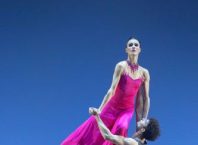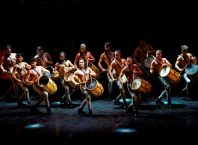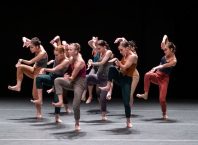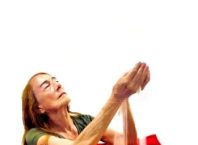Wallflower. The ones who are not dancing, the ones who disappear, shrink into the background, become invisible. Or is it something that emerges from the wall, opening, blossoming, divulging its secrets? Perhaps it is a question of the observer, if there is someone looking, then what is hidden may be revealed.
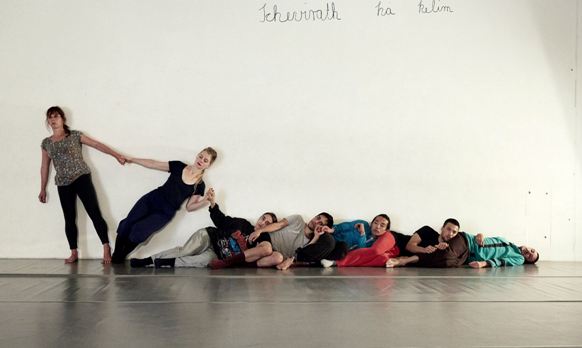
When the walls in question are the walls of a museum, anything is possible. Inbal Pinto and Avshalom Pollak are now realizing a dream they have had for many years: to create a work within the Tel Aviv Museum of Art. Currently in rehearsal, Wallflower which will premiere on July 15, 2014, has been developed within and in relation to, the sculpture gallery of the museum. It’s a vast space, with walls that seem to go up forever before they meet the ceiling. The gallery does not house a permanent exhibition, and it now contains the living sculpture that is the process of making a dance performance.
Pinto and Pollak, working together on choreography, costumes and set design, not only create dances, each work exists within a world of its own, presented onstage. Yet in creating this world, they are always conscious that it exists within another world, the environment of the place itself, with its physical attributes, its history, the associations and feelings concealed beneath the floor, behind the walls. All these elements become part of the process, the subconscious of the work.
Invited to view a rehearsal, on entering the gallery I saw that the walls have been painted in black and white. A minimalist palette dividing space into straight lines and the dichotomy of opposing forces. This is where the work takes place: the work of creating Wallflower, and the performance itself. A supporting pillar, painted entirely black, is invisible when viewed from one side of the room, merging with the black walls; walk over to the other side and the pillar, black against walls of white, becomes a presence, a sculptural entity. The choreographers have transformed the space, and the space informs the dance.
“You can’t hide in a museum,” says Avshalom, smiling, referring to the absence of any backstage or wings. Everything must take place in full view of the audience. For Pinto & Pollak, this is not an obstacle, but an element of this work, in which the space itself becomes an actor. Entering the gallery, Pinto and Pollak strived to empty themselves of past ways of seeing and moving, and relate to this space, its character and possibilities. The focus is on matter itself, the elements and their attributes, the ways of being and moving that emerge from these materials. Breaking away from the conventions and patterns of their own choreographies, breaking down phrases of movement to the essential elements, breaking the form to create new forms, a different way of moving in this space. Inbal told me: “We wanted to break everything that we are and take it apart.”
It is a space in which worlds exist in parallel. I watched Inbal Pinto and Dina Ziv work with the dancers, while Avshalom Pollak worked with the musicians. Quiet conversations, moving bodies, breath and voice, the melodic turnings of a music box. Until now, the making of Wallflower has been set against silence, while the musicians worked on composing the music in Japan. Now Umitaro Abe, Mayu Gonto, and Hirofumi Nakamura, who have each worked with Pinto & Pollak on different projects, have arrived in Israel to continue to develop the music here, and the joint rehearsals begin. Three accordions, a violin, a small paper bag, four wine glasses filled with water, a kazoo, Mayu Gonto’s hands dance, fingers tracing shapes in the air as she thinks through a phrase. The music and musicians are a visual element, as much a physical presence as the dancers. One of the musicians has drawn a story board of the music, sketching out the dance and score in penciled lines on brown paper, the strokes swift and delicate. My eye lingers on a word: Breath.
“It’s not just the lungs,” Inbal tells the dancers, “breathe in the body, between the hips and chest, it’s about the way you’re going to bring in the air.” The dancers stand in a cluster, breathing and letting the breath shape their bodies and features. The rhythm of the breath creates forms, they are a single organism of many disparate parts, a clump of colorful balloons, a crowd of fascinating creatures. Almost hidden within the center of this cluster, a different sound is heard: the slap of a hand against the flesh. A dancer emerges – Noga Harmelin – and the brief moment I witness is unlike anything I have ever seen in the Pinto & Pollak repertoire: sharp, angular, forceful. As I watch Noga, her movements remind me of a line from songwriter Suzanne Vega: “”She’s growing straight lines/Where once were flowers.”
The performers are an ensemble of imaginative, creatively bendy dancers and actors, deeply involved in the artistic process: Avidan Ben Giat, Zvi Fishzon, Noga Harmelin, Cordelia Lange, Mayumu Minakawa, Mirai Moriyama, Andrea Martini, Stav Struz, Tom Weksler, Gil Shachar. They move in a group, hugging the walls; they form a chain along the floor – an interlinked string of molecules, a daisy chain; they move in pairs and trios in the center of the space, leaning in, sharing weight, shifting and recombining: it’s action on the molecular level, the view through a microscope or perhaps it is all happening on another scale, stars igniting, clouds of matter drifting, glowing in a distant galaxy.
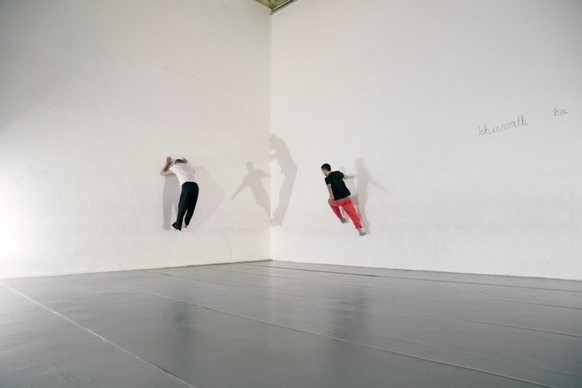
And this is just a glimpse, there is so much more hidden than revealed. Yoann Tivoli will illuminate and shape the space with his lighting design. The dancers now rehearsing in their comfortable sweats and T shirts will be wearing couture costumes, a colorful knit second skin at once abstract and provocatively naturalistic. Textile designer Moriel Dezaldeti collaborated with Pinto & Pollak on the costumes, along with Rinat Aharonson, from the thread (woven in Israel) to the one-of-a-kind creations with hand knit elements that will play their own part in the visual aspect of this work. As the costumes are still in the making, no one has yet seen Wallflower as it will look in the colorful costumes, not even the choreographers. For now, it is still a dream, a vision soon to be realized. “I think it will be like a kind of action painting,” said Inbal, invoking that other (sounds-like) Pollak: Jackson.
Performances will take place at the Tel Aviv Museum of Art, 27 Shaul Hamelech Blvd. beginning Thursday, February 19, 2015. Tickets: 03-6077020.
Wallflower
Choreographers, Costumes and set design: Inbal Pinto, Avshalom Pollak; Lighting designer: Yoann Tivoli; Composing and musical performance: Umitaro Abe, Mayu Gonto, Hirofumi Nakamura; Textile and co-costumes designer: Moriel Dezaldeti; Co-costumes designer: Rinat Aharonson; Sewing: Ela Givol, Rosalind Noctor; Rehearsal Manager: Dina Ziv; Performers: Avidan Ben Giat, Zvi Fishzon, Noga Harmelin, Cordelia Lange, Mayumu Minakawa, Mirai Moriyama, Andrea Martini, Stav Struz, Tom Weksler, Gil Shachar; Production coordinator: Keren Yuval; Master carpenter: Gilad Bonneau; Lighting: Oren Elimelech; Sound: Asaf Ashkenazy; Wardrobe: Ela Givol

